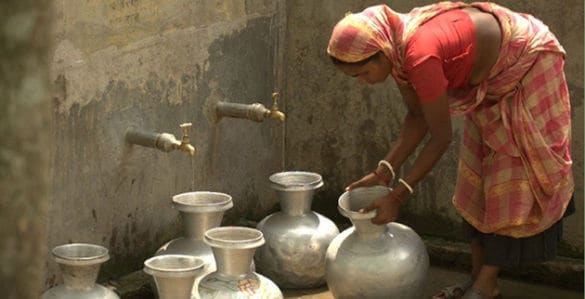According to the latest national assessment, 85 percent of the people in Bangladesh have access to safe drinking water. However, a multiyear, interdisciplinary study of water use in one of the country’s rural areas conducted by a team of Vanderbilt University researchers has uncovered two major problems not reflected in the national statistics.
“The most surprising and disturbing result of this research was discovering that, in the communities we studied, there was almost no reliable year-round access to safe drinking water, while most residents did not know that their water was unsafe. Even when almost all water was unhealthily salty and had unsafe levels of arsenic and other chemicals, most people reported that the water tasted good and used it regularly,” summarized co-author Jonathan Gilligan, associate professor of earth and environmental sciences at Vanderbilt.
The paper describing their results—”Drinking water insecurity: water quality and access in coastal south-western Bangladesh“—was published last June in the International Journal of Environmental Health Research. In March, the journal’s publisher, Taylor & Francis, featured the article to mark World Water Day and made it free for anyone to read through the end of May.
“To mark this year’s World Water Day, we wanted to draw attention to a range of articles that both mark the latest thinking in the field and have ‘real world’ impact,” explained Daniel Pullin, content coordinator of the Taylor & Francis Group. “So we put together a special research collection designed to take users on a research journey, contextualizing today’s problems and offering some thoughts for the future. The Vanderbilt University research article was a perfect fit. Against the backdrop of 663 million people globally living without a safe water supply close to home, this research is especially important in raising awareness during a time of crisis.”
The researchers studied several rural communities in southwestern Bangladesh, combining social and natural sciences to understand regional and seasonal variation in water security.
Working with Bangladeshi collaborators, team members spent many weeks in the field over several years, conducting interviews and surveys to learn where households got their water. They also measured water quality in both rainy and dry seasons.
They found that during the rainy season most people collected rainwater, which provided them with an ample supply of safe drinking water. During the dry season, however, they discovered that the inhabitants relied on pond and well water that frequently contained unhealthy levels of arsenic and other contaminants.
This effort revealed two largely unrecognized challenges for water security in Bangladesh. First, that there are serious regional and seasonal water insecurities that do not show up on national reports; and second, that communities with unsafe water often do not realize it.
“Fixing a problem begins with knowing that there is a problem, so we are continuing to work with colleagues in Bangladesh to extend this research to many more communities and to raise awareness of these critical issues,” Gilligan said.
Members of the interdisciplinary research team include environmental engineering doctoral student Laura Benneyworth, Professors of Earth and Environmental Sciences John Ayers and Stephen Goodbred, earth and environmental sciences master’s students Gregory George and David Fry, Professor of Sociology Katharine Donato and sociology doctoral student Bhumika Piya from Vanderbilt; Amanda Carrico from the University of Colorado at Boulder; and Rezaul Karim and Farjana Akter from Khulna University in Bangladesh.
This work was supported by Office of Naval Research grants N00014-11-1-0683 and IRB 130235.


